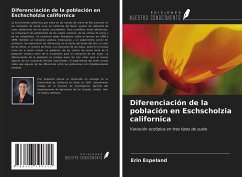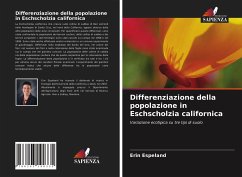
Population differentiation in Eschscholzia californica
Ecotypic variation on three soil types
Versandkostenfrei!
Versandfertig in 6-10 Tagen
32,99 €
inkl. MwSt.

PAYBACK Punkte
16 °P sammeln!
The Eschscholzia californica growing in the Ben Lomond sand hills in the Santa Cruz mountains of Northern California appears different from other populations in the surrounding areas. To quantify these differences, populations in coastal, sand hills, and serpentine soils were compared. Phenotypic data were collected from the field in 1998 and 1999. Molecular analyses and a common garden experiment were also performed. Differences in torus rim width, flower color, flower number, and leaf coloration were examined in both the field and common garden. The sand hills population from both the coasta...
The Eschscholzia californica growing in the Ben Lomond sand hills in the Santa Cruz mountains of Northern California appears different from other populations in the surrounding areas. To quantify these differences, populations in coastal, sand hills, and serpentine soils were compared. Phenotypic data were collected from the field in 1998 and 1999. Molecular analyses and a common garden experiment were also performed. Differences in torus rim width, flower color, flower number, and leaf coloration were examined in both the field and common garden. The sand hills population from both the coastal and the serpentine populations for leaf coloration. Population differentiation occurred among all three sites for at least some of the floral characters examined. The common garden experiment indicates that some of the differences among the populations are phenotypically stable.












